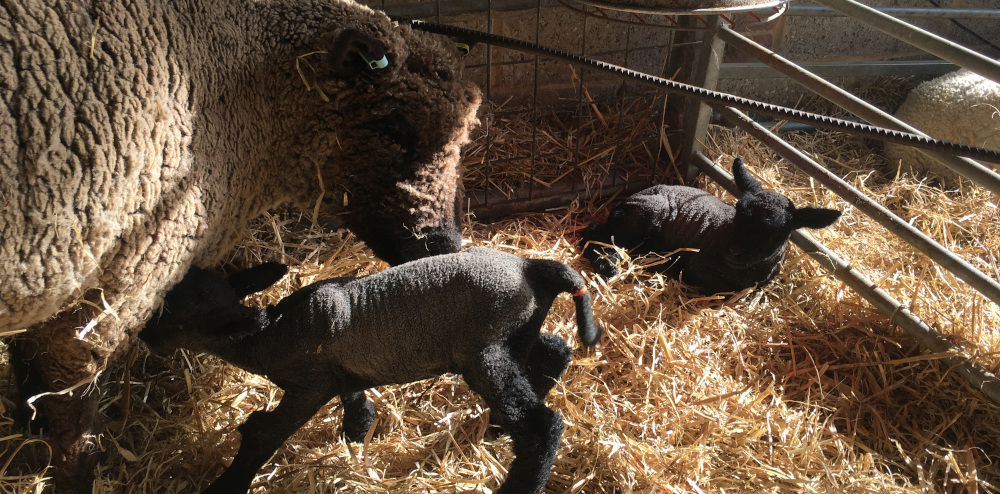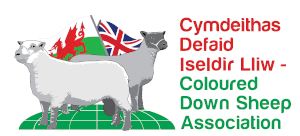 Coloured Down Sheep were developed primarily from Southdown Sheep and the association are very proud of this historic association. The development of our progenitor breed the Southdown is described below.
Coloured Down Sheep were developed primarily from Southdown Sheep and the association are very proud of this historic association. The development of our progenitor breed the Southdown is described below.
‘John Ellman and the Southdown Sheep’ by Paul Wakeham-Dawson, MA Dip Agric (Cantab), who was a breeder of pedigree Southdowns, Council Member of the Southdown Sheep Society and Trust member (originally published in 1991)
In 1791, in the last decade of the 18th century, a Sussex farmer was nearing the zenith of his career which was to bring him lasting fame.
John Ellman was born in 1753 at Hartfield in Sussex, at about the time when Britain’s population had begun its significant and lasting explosion. It was in the mid 1750s that, for the first time, Britain was forced to become a net importer of its food.
In 1761 John Ellman’s father, Richard, took the tenancy of Glynde Farm, a parish which lies under Mount Caburn near Lewes and looks towards Firle Beacon – the highest down in the eastern chain. On the death of his father in 1780, John succeeded to the tenancy of the 580 acre farm on the Hampdean estate. Eight years later, Arthur Young described John Ellman as a “very considerable and intelligent farmer.”
Glynde Farm included 150 acres of downland grazing – this represents a rather low percentage of sheep run for a downland farm; 150 acres of corn and a large hay allocation of 200 acres. John Ellman kept 20 cows of the ‘red Sussex breed,’ a bull and the followers; he fattened ‘best Sussex hogs’ – a pig breed now extinct. Three eight-oxen teams were available for farm work–the ploughing, rolling and carting, and these were supported by nine cart-horses. The Southdown breeding flock consisted of 500 breeding ewes plus the stud rams and wethers.
At the annual harvest home Mr. Ellman entertained some 80 men, women, and children who enjoyed 16 stones of beef; eight stones of mutton, one hundredweight of Sussex plum pudding, together with bread and 50 gallons of ‘strong beer.’
There were no ‘pedigree’ breeds of sheep in Ellman’s day but differing districts had their own local type – some becoming ‘improved,’ some not. Arthur Young described Ellman’s Southdowns as “hornless; speckled faced and legs; thick in the shoulder, open-breasted and deep. The fore and hind legs stand wide; round and straight in the barrel; wide loins and hips. The wool was close and hard to the feel and ‘curdled to the eye’.” Clearly, a mutton breed was rapidly being developed on the Sussex downs – one which was ‘fold-tolerant’ and thus fertilised the chalky soils to grow much needed wheat and able to supply the burgeoning population with equally necessary meat. In 62 years, from 1750 to 1812, the population of the UK doubled to approximately 12 million people.

Method of improvement
John Ellman’s method of improvement was by selection. He chose his 60 best ewes every autumn and put them to his finest ram. The remaining ewes, about 440, were then put to his next best three rams. Five or six days later he added two more rams and then repeated this every four or five days until each ram had about 50 ewes.
Apart from being the leading breeder of Southdown, John Ellman was said to be the ‘instrument of disseminating this useful breed over the whole Kingdom.’ In 1787, the first Southdown ram to sell for 10 guineas went to Lord Waldegrave in Essex who bought a pair of rams from Glynde for £21. In 1796, Arthur Young himself purchased 80 Ellman ewes which went to Suffolk to become the fore-runners of the famous Suffolk breed of sheep.
In 1791, the celebrated ‘Coke of Holkan’ bought 500 Southdowns from the best of the Sussex flocks – together with four Ellman rams, the latter being priced at 70 guineas in total. 1796 saw a Dorset farmer paying Ellman 50 guineas for a ram. In 1802 the Fifth Duke of Bedford hired a Glynde ram for two seasons. This cost him 300 guineas.
An argument now began to rage as to whether Bakewell’s ‘New Leicesters’ or the Southdown was the better sheep – one noted farmer, the sixth Duke of Bedford, sold his Leicesters in 1807 and bought 50 Ellman ewes in their place.
Export orders arriving
By 1803, the Southdown had been introduced to Ireland and Scotland and overseas export orders were arriving. The King sent two Ellman rams as a present to the Emperor of Russian, and, later, John Ellman’s son (another John) sold sheep to New South Wales, Portugal, America and the West Indies.
John Ellman, famous throughout the farming fraternity, died at Lewes in 1832 at the age of 79. He was “a knee-breeches man with top boots; tall, coated for horseback and with a characteristic farmer’s hat not scanty of brim…” He was more than content to remain a farmer and refused even an earldom. A lifetime spent with royalty, dukes and peers failed to turn his head, and even William Cobbett praised Ellman’s equal concern for all manner of people and the right ordering of his parish of Glynde.
The pure bred Southdown sheep, however, were only part of the story, as the use of Southdown rams on local sheep types lead eventually to the formation of recognised new breeds. All the down breeds were developed in this way but it can be argued that nearly all the sheep breeds of the world are not without an infusion of Southdown blood at some stage or another in their development.
Continued increase in distribution and importance
After Ellman’s death, the Southdown continued to increase in distribution and importance. Second only to John Ellman was Jonas Webb, who farmed similar chalk type soils near to Cambridge (1796-1862). Beginning with Ellman stock in 1822, Webb used in-breeding to fix his Southdown type and achieved nearly the same degree of fame as the breed originator. In 1855, Webb presented a 500 guinea prize ram to the Emperor of France. When he retired in 1861, 1,000 people attended Webb’s sale and the stock went to nearly every country on the Continent and to North and South America, Canada and Australia. In the New Zealand Flock Book, flock number one was founded in 1863 from descendants of Webb’s Southdown ewes.
The zenith of registered Southdowns in the United Kingdom was in 1908 when there were 367 flocks with an average of over 300 ewes in each. In addition to this there were down land ‘working flocks’ of unregistered sheep.
The Great War period of 1914-1918 heralded a permanent change in the Southdown’s status. This was due to the scientific introductions into farming and the flood of overseas imported food as peace became reestablished. The combined effects of inorganic fertilizers and the near demise of homegrown wheat production as a profitable enterprise rendered the folded downland flocks on England’s lighter soils increasingly redundant. Thus between 1900 and 1930, Cambridgeshire, Suffolk, Norfolk, Berkshire, Wiltshire, Hampshire, Essex, Dorset, Lincolnshire, Bedfordshire, Oxfordshire, Hertfordshire and Sussex reduced their flocks of sheep by over 50 per cent.
Grassland counties not so affected
The grassland counties were not so affected. From about 1924 labour costs began to increase and coincided with the introduction of the profitable sugar beet root crop in place of much of the old folded roots – turnips, swedes and kohl rabi. As the sugar beet tops could be folded with some ease after the roots had been taken to the factory, the crop spread rapidly on the better soils. On the South Downs this crop was not a general success and milk production increased at the expense of sheep-and-wheat systems, saving the downland farms from total financial collapse.
The Southdown breed proved adaptable and found itself another role to play in the agricultural industry, changing from an arable to a grassland sheep and building an important pedigree export trade. In 1923 246 animals were exported, mainly to New Zealand which was rapidly developing its famous ‘Canterbury Lamb’ trade. This was a Southdown cross which fed Britain for many decades with small tender joints.
By 1937 the export figure was up to 459 but the Second World War (1939-1945) dealt the quality meat market an almost lethal blow. U-boats and rationing demanded quantity for survival and the small, quality joints became outclassed. Unfortunately, quality has never become reinstated and large carcases meant more profit both during the War and the years which followed. Even so, the breed survived and the 40 remaining flocks after the War increased to 93 in 1957. In 1951, 1953, 1954, 1955 and 1956 the Southdown carcases won the Smithfield championship and a small live export trade was redeveloped.
The 1970s saw a strange intrusion into British farming. Britain, the “Stud Farm of the World” for a century, turned its back on its native breeds – to such an extent that forward-looking farmers and scientists hastened to form the Rare Breeds Survival Trust. Many authorities would agree that the minority breeds could feed Britain – and support its farmers – as well as, or better, than the imported breeds, many of which owe their origin to past British exports of our native stock.

